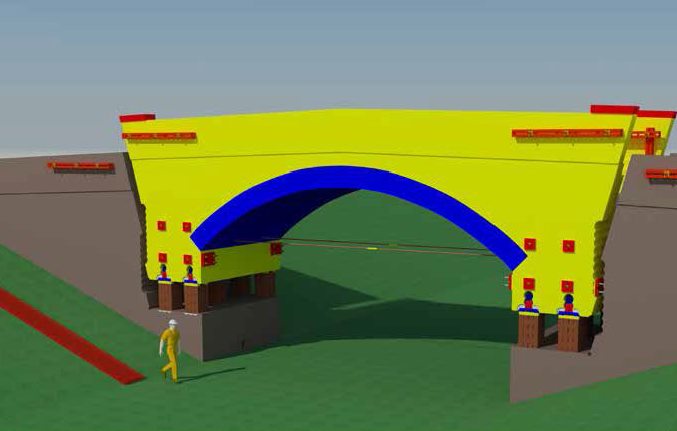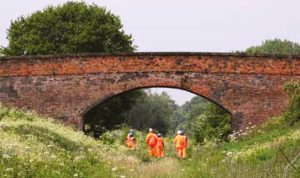Innovation is a tortuous path which requires a great deal of support from a wide spectrum of people. The Department for Transport has recognised the importance of promoting innovation and engages RSSB to manage the dissemination of funding to companies and individuals through its innovation programme. This is a scheme dedicated to funding idea development and facilitating access to live rail proving grounds.
In February 2014, RSSB’s Innovation Programme invited participants to an event entitled “The Avoidance of Bridge Reconstruction”, during which it was estimated that 25 per cent of the cost of electrification is attributed to bridge reconstruction.
Attending this event was Freyssinet, a structural repair contractor, more often than not to be found beneath a highway bridge doing bridge jacking and bearing replacement, concrete repair or cathodic protection. Acknowledging the call from the rail industry for new entrants to help deliver the CP5 expenditure plan, Freyssinet formally set up its Rail Division in 2013 with the aim of developing new solutions as well as transferring skills between sectors.
The Avoidance of Bridge Reconstruction competition was trying to find an alternative to demolishing overbridges, which often becomes necessary when electrification or larger rolling stock needs to be accommodated on a line. Hundreds of overbridges have been demolished, at great cost to Network Rail which hoped there must be a better way.
Jacking a masonry arch bridge
Freyssinet teamed up with Bill Harvey at that event. Bill is a renowned masonry arch bridge expert who already had the idea of how to vertically jack arches, without having a route to market. Freyssinet provided that route – and so the ElevArch® team was born.
Each brick in a masonry arch is held in place by the support offered by the neighbouring brick, so a thrust line develops around the arch and down into the ground. Provided the abutment, wing walls and soil are able to provide an equal and opposite reaction, the arch remains stable. It takes a brave person to contemplate disturbing this most fundamental of structural stability rules, but that was Bill Harvey’s plan.
The team, along with eight other companies exploring totally different concepts, won funding in 2014 from RSSB for a desktop study to explore the feasibility of the concept. In 2015, ElevArch was chosen, with four others, to advance into phase two of the competition – the full-scale demonstrator.
A suitable structure was located on the East-West Rail phase 2 route. This is Moco Farm occupation bridge, which carries a live farm access over a mothballed railway that is currently being recommissioned as part of the East-West route between Bicester and Bletchley. It is an unremarkable brick segmental arch bridge, 4.3 metres wide with a 10.1 metre span and dating back to 1850. But Robert
Stephenson designed the line and, whilst it is not a listed structure, it nevertheless seems a shame to lose it. The structures on East-West Rail phase 2 need an average of about 900mm extra headroom beneath them for the OLE and kinematic envelope. The traditional options are bridge reconstruction and track lowering and, if the ElevArch trial works, 10 similar bridges on the route are possibly suited to the technique as well. Other lines look promising for exploiting the technique too, such as west of Leeds on the Trans-Pennine project and the Midland main line.
ElevArch® explained
So, what is ElevArch®? It is a patented technique which involves cutting the arch free from its abutments and wing walls so it can be jacked skywards to enlarge the space below it. The sequence of operations is key to maintaining that all-important thrust line. A horizontal saw cut is made through each abutment just below the arch springing in conjunction with coring five holes horizontally into each abutment. Vertical lifting jacks are inserted into these holes and they support the weight of the bridge.
The horizontal component of the thrust force is taken by four vertical slip bearings which are inserted into slots cored through the four wing walls. These bearings prevent the arch from spreading horizontally whilst allowing vertical movement. Once they have been grouted in place, it is safe to wire saw cut the rest of the wing walls to free the arch from the foundations and the magic can begin.
The 50 tonne capacity jacks are computer controlled from a central unit to within 0.1mm of each other, thus guaranteeing a fully balanced synchronous lift. In late September 2016, Moco Farm bridge will be jacked 900mm into the air. As the jacks lift, hardwood timber crib stacks will be inserted beneath the jacks to support the bridge each time the jack foot retracts. The lift will take about six hours, during which constant monitoring will verify that the arch is behaving as predicted.
The arch will then be lowered by 465mm so that re-profiling of the approach ramps is unnecessary for the trial. Thus the bridge will be left 435mm higher than the starting position and the gap in the abutment where the bridge has been lifted will be faced with brickwork and flooded with concrete to restore permanent support so the jacks can be recovered for reuse. The bearings are left in the wingwalls with the saw cut grouted up having first had the facing brickwork made good.
An additional option
The methodology has been developed to minimise the intrusion into the rail environment as much as possible. A bridge reconstruction or track lower can often require several days of railway closure. With ElevArch, in most situations, there will be a Rules of Route possession to erect the trackside safety barrier and another to remove it at the end. The jacking is intended to take place early on Sunday morning in another Rules of Route possession as it will only need about six hours to complete the lifting operation.
The coring, sawing, grouting and other tasks can all take place from behind the barrier using relatively light equipment. So, not only are the direct costs of this technique expected to be significantly less than bridge reconstruction or track lowering, but the demands for track time will be reduced as well. It is also perceived to be less risky as there is no need for a large crane with all its access and weather susceptibility issues.
The ElevArch® technique is not expected to replace bridge reconstruction or track lowering completely, but rather join that pair as a third option to be selected by the engineer as the solution when the situation is most appropriate.
It is expected to be of significant interest in heritage situations when track lowering isn’t viable – it’s better to sympathetically move a heritage structure than remove it altogether.
With something in the region of 500 overbridges getting in the way of Britain’s electrification programme, the future for this bold but simple technique is expected to be bright.
Kevin Bennett
Article appeared in Rail Engineer Magazine, August 2016. Download the feature here.
Kevin Bennett is Freyssinet’s sales and technical director. Freyssinet wish to acknowledge the tremendous support given by the East-West Rail team in bringing this concept to trial.
For more information about ElevArch® , contact info@freyssinet.co.uk


